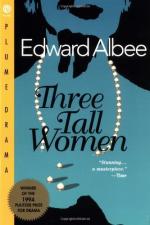|
This section contains 636 words (approx. 2 pages at 400 words per page) |

|
Lane A. Glenn is a Ph.D. specializing in theatre history and literature. In this essay he examines how Edward Albee combines elements of absurdist drama with realism in Three Tall Women.
As much as anything else, the popular success of Edward Albee's 1994 Pulitzer Prize-winning drama Three Tall Women can be attributed to the fickleness of American scholars and theater reviewers. As numerous articles and interviews pointed out during the show's lengthy New York run, Albee was once the darling of the American Theater scene. In the early 1960s he was hailed as the next Eugene O'Neill and was considered a literary genius of the age.
He quickly fell out of favor, however, and for more than twenty years his plays received only lukewarm, or even hostile response from New York reviewers. Albee found work teaching and directing, while he continued to write plays.
What changed? What...
|
This section contains 636 words (approx. 2 pages at 400 words per page) |

|




